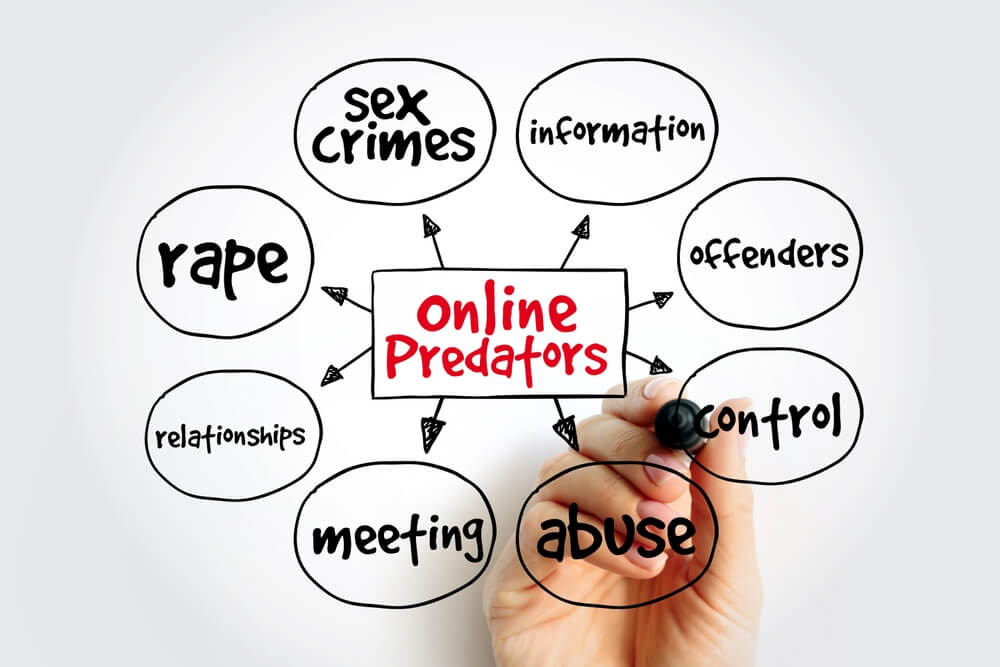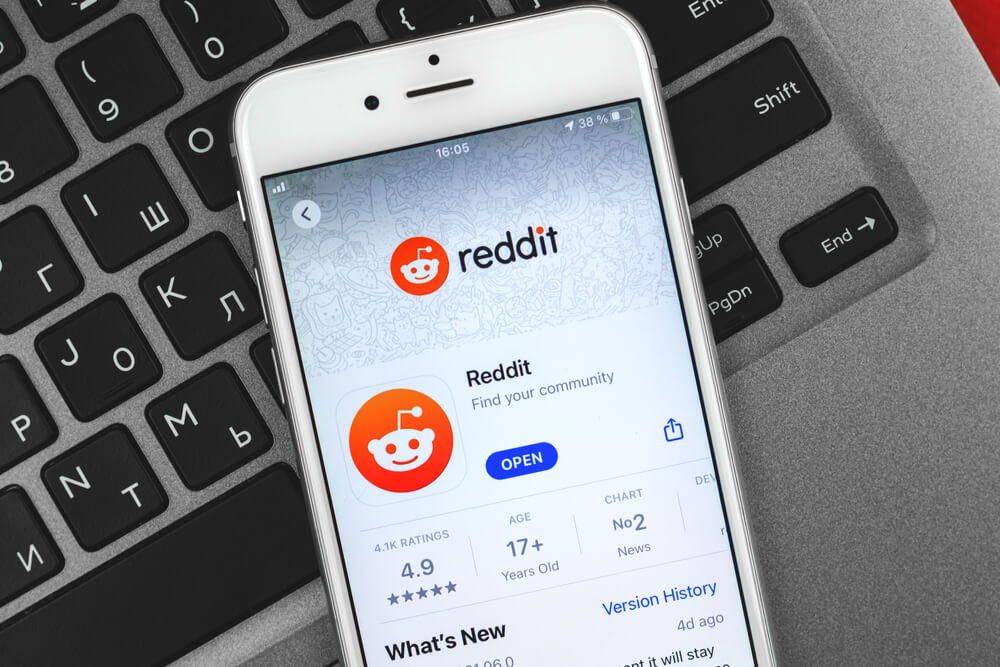How to Protect Your Child from Online Grooming: Signs, Statistics, and Prevention Tips

There are dangerous people online who build trust with children only to exploit and hurt them. Unfortunately, not everyone is who they say they are behind a screen, which can lead to child grooming. To keep your child safe online, parents should know what is grooming and how they can prevent it from happening to their child.
Contents:
- What is Grooming?
- Signs of Online Grooming
- Effects of Grooming on a Child
- How to Report Grooming
- How to Deal with Online Grooming
- How to Support Your Child or Teen After Grooming
- FAQs
What is Grooming?

AlyoshinE/Shutterstock.com
Child grooming abuse is when an adult tricks a young child online to exploit or abuse them. Predators often pretend to be the same age as the child to build trust. They can use flattery, gifts, or threats to gain control. The goal is usually to make the child share explicit content or meet in person. Groomers may try to isolate the child from their family and friends. Knowing these tactics can help parents keep their children safe online.
Types of Grooming
Grooming can take many forms, each designed to manipulate and exploit a child. One common type is emotional grooming, where the predator tries to build a close friendship or romantic connection. They might give the child compliments, gifts, or constant attention to gain their trust.
Sexual grooming takes this manipulation further. The predator might start talking about sexual topics or share inappropriate images. They may pressure the child to respond by sending explicit photos or videos.
Another type is financial grooming. Here, the predator offers money or gifts in exchange for personal photos or videos. This can make the child feel they owe the predator, trapping them in their control.
In extreme cases, there’s physical grooming. This is when the predator aims to meet the child in person, sometimes traveling long distances to do so. Additionally, blackmail grooming occurs when the predator threatens to share private images or information unless the child does what they want.
Each type of grooming uses different tactics to exploit a child’s weaknesses. Knowing these signs can help parents take steps to protect their children online.
Real-Life Cases of Grooming

Prixel Creative/Shutterstock.com
Over the last four years, online grooming has increased by a whopping 80%. Think about the scary case of a 14-year-old girl who was tricked by a man she met on a gaming app. He pretended to be her age and slowly convinced her to share personal information and even explicit photos, which he later used to blackmail her.
Sadly, this isn’t a rare case. Statistics show that 1 in 5 kids aged 12 to 15 have been contacted by an online predator. And only 25% of children sexually solicited online tell their parents.
Another case involves a minor 12-year-old boy who was lured into meeting a man he thought was a 13-year-old girl, but luckily, the police stepped in before anything could happen.
Just last year, the police identified 70 apps and games where grooming takes place. This shows the problem is huge and everywhere. It’s very important for parents to be aware and understand these dangers to help keep their kids safe.
Who is at Risk of Online Grooming?

Iren_Geo/Shutterstock.com
Online grooming can happen to any child, but kids between the ages of 12 and 15 are especially at risk. These are the years when they spend more time online for school, socializing, and playing games. This makes them easy targets for predators who often pretend to be other kids to gain their trust.
Children who are lonely, have low self-esteem, or aren’t supervised well are even more vulnerable. Predators know how to spot and take advantage of these weaknesses.
It’s important for parents to understand that an online predator could approach any child. Keeping the communication lines open and being watchful is key to protecting your child from these threats.
Does Child Grooming Only Happen Online?
Child grooming can happen both online and in person. While the internet makes it easy for predators to find and talk to kids, real-life settings can be just as risky. This can happen in places like schools, parks, or even within the family.
Predators might try to build trust with the child by giving gifts or special attention to win them over. Just like online grooming, in-person grooming is a slow process where the predator manipulates and controls the child’s behavior and thoughts.
Both types of grooming are very dangerous and can seriously affect a child’s safety and well-being.
Signs of Online Grooming

SB Arts Media/Shutterstock.com
As a parent, it’s important to be aware of the warning signs of online grooming. If your child spends a lot of time online and talking with people on interactive games and social media, you’ll want to look for these signs.
Specific Signs of Online Grooming
- Secretive Behavior — Your child may start to keep secrets, lie, and hide what they do online, like quickly closing tabs or not telling you about their online activities.
- Emotional Changes — Watch for changes in mood or higher anxiety, especially after they’ve been on the internet.
- New Friends — They might mention new friends you don’t know, particularly someone much older.
- Excessive Internet Use — Spending more time on the internet, especially late at night, can be a red flag.
- Unexplained Gifts — Receiving gifts, money, or other things from unknown sources.
- Sexualized Behavior — Showing new or increased sexual behaviors or using language that doesn’t fit their age.
- Hiding Conversations — Deleting chat histories or using apps that make conversations disappear.
If you witness these signs in your child and suspect they are being groomed online, it’s important to ask your child about their online activities and further investigate the issue.
Find out how much time your child spends online, which apps they use, and at what times of the day with Kids360. Even kids enjoy this kind of protection!
Portrait and Goals of a Child Groomer

dizain/Shutterstock.com
Child groomers often deceive children by pretending to be the same age. They make fake profiles on social media and game chats to connect with kids.
Their main goal is to gain trust and form emotional bonds. They may spend weeks or even months making a child believe they have a real friendship. Once trust is built, they slowly introduce inappropriate and sexual content.
The end goal is usually to get explicit photos or videos, have sexual conversations, or meet in person for further exploitation.
Predators take advantage of children’s innocence, curiosity, and need for acceptance. They often target those who seem vulnerable or lonely. Using psychological tricks, they may threaten to expose private photos or videos if the child doesn’t comply.
The internet’s anonymity and wide reach make it easier for groomers to contact many potential victims at once, increasing their chances of success.
So, here’s a brief summary to warn parents and children:
Portrait of a Child Online Groomer
- Age and Identity:
- Usuall, an adult male, though female groomers exist. Ages can vary widely. Often pretending to be a younger person to gain a child’s trust.
- Often pretends to be someone the child would trust, such as a peer or mentor.
- Behavior and Communication:
- Starts as friendly, offering compliments and showing interest in the child’s life.
- Quickly becomes more personal, asking about private feelings, hobbies, and daily activities.
- May gradually introduce sexual content or ask for inappropriate photos.
- Avoids direct, face-to-face meetings early on, keeping interactions strictly online.
- May try to move conversations to private chats, away from more public or monitored platforms.
- Online Presence:
- Found on social media, gaming platforms, and chat apps popular with kids.
- Often uses multiple accounts or fake profiles to hide their real identity.
- Psychological Traits:
- Manipulative, patient, and persistent, willing to spend weeks or months grooming a child.
- Skilled in making the child feel special, understood, and increasingly reliant on their friendship.

Tero Vesalainen/Shutterstock.com
Goals of a Child Online Groomer
- Gain Trust:
- To make the child feel comfortable and safe, often pretending to be a close friend or confidant.
- Isolate the Child:
- To distance the child from their parents or friends, encouraging secretive behavior.
- Normalize Inappropriate Behavior:
- To gradually introduce sexual topics, making the child believe that such conversations or actions are normal.
- Obtain Personal Information or Explicit Content:
- To exploit the child by obtaining photos, videos, or private details that can be used for blackmail or further manipulation.
- Arrange a Meeting:
- In some cases, the groomer may try to set up a physical meeting, which is extremely dangerous.
- Maintain Control:
- To create fear or dependency, making the child afraid to tell anyone or seek help.
Read also: 15 Warning Signs That Help to Identify a Child Predator.
Effects of Grooming on a Child

SeventyFour/Shutterstock.com
Grooming can deeply impact a child’s behavior, social life, and mental health. Victims often feel anxious, depressed, and have a hard time trusting others. They might become secretive, withdrawn, or very scared.
At school, they may struggle to focus or lose interest in their studies. Socially, a groomed child might pull away from friends and family, feeling ashamed or confused.
In the long term, the trauma can lead to serious issues like PTSD, self-harm, or substance abuse.
Knowing these effects is important for providing the right support and help.
How to Report Grooming
If you think your child is being groomed online, act right away. Contact your local police and report the situation.
You can also tell the platform or app where it happened. They usually have ways to deal with these issues. Additionally, visit organizations like the National Center for Missing & Exploited Children (NCMEC) and use their CyberTipline to make a report.
Keep any suspicious messages or activities as proof for the authorities.
Your child’s online safety is very important, so don’t hesitate to get professional help if needed.
How to Deal with Online Grooming

Diego Zarulli/Shutterstock.com
Having a child who has experienced online grooming can take some time to help them recover and feel like themselves again.
Helping Children Cope After Grooming
It’s important to give your child a safe space to talk about their feelings. Let them know it’s not their fault and they can share anything with you.
Getting help from a counselor can be really helpful. Teach them about online safety, and encourage them to join positive activities to boost their confidence.
Keeping a routine can make things feel more normal and secure.
Keep an eye on their online activities and talk to them about setting boundaries and saying no. Your constant support and patience are key to their healing.
How to Prevent Online Child Grooming

DimaBerlin/Shutterstock.com
Parents need to be proactive in preventing online child grooming.
- Start by having an open and honest relationship with your child. Encourage them to share their online experiences and assure them they can come to you with any concerns.
- Teach your child about online safety—explain what personal information they should never share and why it’s important to be careful when talking to strangers online.
- Use parental control tools and software to keep an eye on your child’s internet usage. These tools can block inappropriate content and help you spot any suspicious behavior early. It’s also important to set clear rules on how much screen time they can have and which websites and social media they can use.
- Make sure to teach your child about the tricks predators use, like pretending to be their age or giving them lots of compliments. Role-playing can help them practice saying no and setting boundaries. Also, keep computers and other devices in common areas of your home where you can easily see their online activities.
- Lastly, stay updated on the latest apps and social media platforms that kids are using. This helps you understand potential risks and have informed conversations with your child about staying safe online.
Tools to Prevent Online Grooming
One of the best tools parents can use to prevent online grooming is Kids360. This app helps limit screen time, set parental controls, and monitor your child’s online activity. It’s a great way to keep them safe online.
With Kids360, you can block certain apps and websites, so your child only sees safe and age-appropriate content. You can also set daily or weekly screen time limits, which helps balance between online and offline activities.
In addition to these essential features, Kids360 offers interactive tasks and puzzles that encourage your child to learn and grow. With over 4,400 built-in logic and thinking challenges, the app motivates children to engage in self-improvement activities, earning extra screen time as they complete these tasks. This helps them develop time management skills while staying engaged in safe and educational content.
Moreover, the app’s geolocation feature provides peace of mind by allowing you to always know your child’s whereabouts. This added layer of safety ensures that even when they are offline, you have the tools to keep them safe.
Using Kids360 not only protects your child from threats but also encourages open discussions about online safety. Remember, proactive monitoring and open communication are key to keeping your child safe online!
How to Support Your Child or Teen After Grooming

Gladskikh Tatiana/Shutterstock.com
After your child has been groomed online, supporting them is very important. Begin by creating a safe space where they feel comfortable talking about what happened. Listen carefully without interrupting, and let them know it’s not their fault.
Get professional help from a counselor or therapist who understands online abuse. Learn about online safety together to stop it from happening again.
Encourage them to join fun activities and hobbies to build their confidence. Keep talking openly and make sure they know they are loved and supported. This will help them heal better.
Become Aware of the Dangers of Online Grooming and Protect Your Children
Understanding online grooming is essential to keeping our kids safe online. By knowing the signs and taking action, you can make the internet safer for your children. Staying informed and watchful is important.
If this article helped you, please share it with your friends and family. Together, we can protect more children from online predators and offenders. The more we know, the better we can keep our loved ones safe.
FAQs

pathdoc/Shutterstock.com
What is considered grooming online?
Grooming online involves adults manipulating or coercing children through deceptive means of exploitation. Predators build trust, and form emotional connections, often posing as peers, to gain personal information or arrange in-person meetings. The end goal is usually sexual exploitation or abuse.
What are 3 common online grooming tactics?
Common online grooming tactics include:
- Builds trust
- Desensitizes sexual content
- Isolation
Why is online grooming a problem?
Online grooming exploits children’s innocence, leading to severe emotional, psychological, and sometimes physical harm, and it often goes unnoticed due to the covert nature of the interactions.
Is my child being groomed online?
To understand if your child is being groomed online, look for the signs of grooming, check their internet activity, and see who they are talking to online. If you suspect your child is being groomed, seek help from the authorities.
The picture on the front page: Angelina_D/Shutterstock.com
Проверьте электронный ящик




















